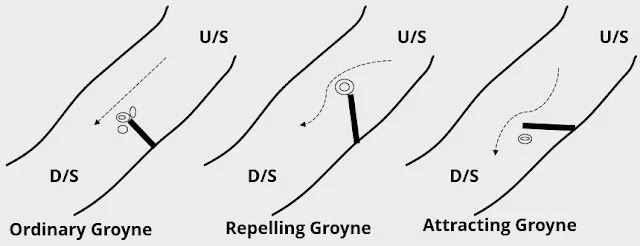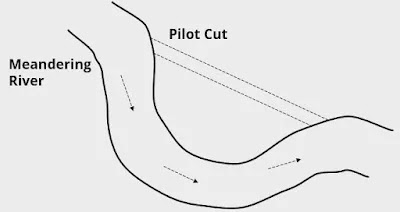Definition of River Training
The process of controlling the flow in river & river bed configuration is called river training works. These are the structural measures adopted in rivers to avoid outflanking & shifting its thalweg due to geomorphological changes in the river. So, the river training works stabilize the river channel along a certain alignment.
Objectives of River Training
- To prevent the river from changing its course & to avoid outflanking of hydraulic structures like a bridge, weir, aqueducts, etc.
- To prevent flooding of surrounding countries by providing a safe passage of floodwaters without overtopping the banks.
- To protect the river banks by deflecting the river away from the attacked banks.
- To ensure effective disposal of sediment loads.
- To provide minimum river water depth required for navigation.
- To prevent additional areas to be submerged due to afflux.
Methods of River Training
Different methods employed for the purpose of river training are as follows:
- Marginal Bunds/Marginal Embankment/Levees
- Guide Bund/Bell's Bund
- Spurs/Groynes
- Artificial Cutoffs
- Pitching of Banks & Provision of Launching Aprons
- Pitched Islands
Marginal Bund / Marginal Embankment / Levees
These are the earthen embankments running parallel to the river & at some distance from the river. These are the flood embankments in continuation of guide bunds designed to contain the floodwater within the flood plains of the river.
Guide Bund / Bell's Bund
These are the bell mouth-shaped bunds constructed on either side of a river in order to restrict the width of the waterway across the hydraulic structures. It was first introduced by Mr Bell so-called Bell's Bund. These are also earthen embankments with stone pitching on the slopes facing the river water.
Spurs / Groynes
These are embankment-type structures constructed transverse to the direction of flow. It extends from the bank into the river. These are also called transverse dykes. These are constructed to attract or deflect the river water from the river banks. Spurs or Groynes are of the following types based on their alignments.
- Ordinary Groyne
- Repelling Groyne
- Attracting Groyne
Artificial Cutoffs
Meandering rivers are induced to flow in a straight path by constructing the artificial cutoffs. A pilot cut is excavated in case of a river in an erodible bed & the flood water gradually enlarges the pilot cut while shifting its path.
Pitching of Banks & Provision of Launching Aprons
The river banks are protected by stone pitching, brick laying, vegetative growth, etc at the bank of the river. In order to protect the toe of the river bank, the launching apron is extended from the toe of the bank into the river bed.
Pitched Islands
These are the artificial islands constructed at the river bed. It consists of a sand core protected by stone pitching. It obstructs the flow of the river & turbulence is created around it. Due to the turbulence generated, the river bed gets deepened at the vicinity of the island & holds the flow permanently thus attracting the flow away from the attacked bank.


Thank you I am glad about the encouragement! I love your site, you post outstanding.hollankken
ReplyDeleteyou're most welcome.
Deleteshort sweet and very effective content
ReplyDeletei kindly request you to cover some topics :
1) component of gravity water supply system
2) instillation and repair work of simple p[umbing fittings
3) instillation and repair work of minor sanitary fittings and fixture
thank you for the response 🙂
DeleteThank you sir. All these notes are highly valuable.
ReplyDeleteIts good notes
ReplyDelete